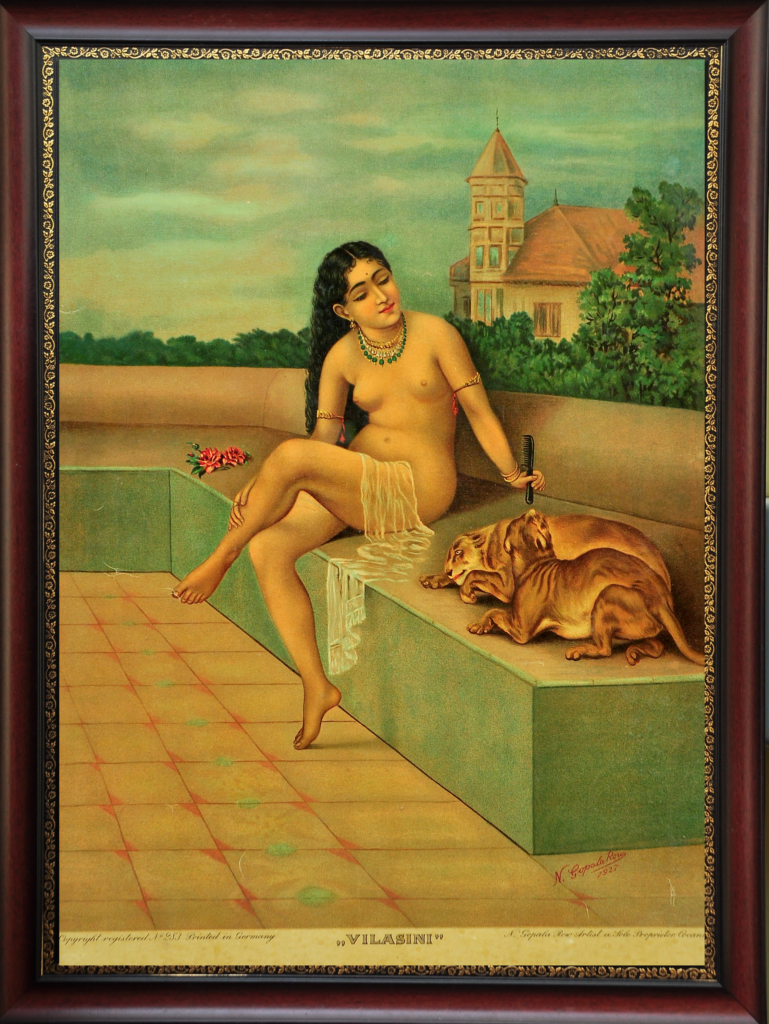Vilasini
The oil on canvas painting “Vilasini,” created in 1927, is considered N. Gopala Row’s most brilliant work. He depicted Vilasini as a delicate flower, reflecting his profound love and understanding of women’s fragility and beauty. Gopala Row was an extraordinarily innovative artist whose contributions significantly shaped the trajectory of Indian art. His ability to capture the expressions of his characters left viewers amazed by the liveliness of his works.
Vilasini, from interpretations of the Mahabharata, is often portrayed as a celestial nymph or dancer who uses her charm to allure Arjuna. Sent by the gods to test his focus and dedication, her enchanting dance serves to highlight themes of desire, duty, and the challenges heroes face amid distractions.
In this captivating painting, Vilasini is depicted as a gracefully nude figure, her long hair flowing freely as she tilts her head toward two playful lion cubs beside her. With one hand resting on her leg and the other holding a delicate comb, she exudes serene elegance. Positioned atop a stone terrace, she is accompanied by two rose flowers nearby, while the lush trees and charming house in the background create a tranquil setting. The vibrant colors and the intricate flooring enhance the beauty of the scene, making this an exceptional work of art. A small, transparent cloth drapes over her leg, and her toes gently touch the ground, adding life to this enchanting moment.
Here’s a more comprehensive look at her
character and significance
Apsara Background
Vilasini is typically portrayed as a celestial nymph (apsara) known for her beauty and grace. Apsaras are often tasked by the gods to distract ascetics or heroes to prevent them from achieving extraordinary powers through penance.
Role in Temptation
Vilasini’s interactions usually revolve around themes of temptation. Her character often embodies the allure of earthly desires, presenting challenges to those on a righteous path. This makes her a symbol of the struggles between spiritual aspirations and worldly attractions
Connections to Heroes
In Telugu adaptations, Vilasini’s encounters with characters like Arjuna are emphasized. These encounters serve to highlight Arjuna’s strength of character, as he often resists her charms to remain focused on his duties and goals.
Cultural Symbolism
Beyond her role in the Mahabharata, Vilasini represents broader themes of beauty, desire, and the transient nature of life. Her presence in stories reflects the idea that while beauty can be captivating, it is often fleeting and may lead one away from their true purpose.
Variations in Adaptations
Different regional interpretations of the Mahabharata might portray Vilasini with varying degrees of depth. In some narratives, she may have a more significant role, while in others, she serves primarily as a plot device to illustrate moral lessons.
Literary Appearances
Vilasini has appeared in various literary works, plays, and performances in Telugu culture, where her character is used to explore themes of love, duty, and the consequences of desire.
Desire vs Duty
The tension between personal desires and the obligations one has can be seen in Arjuna’s resistance to Vilasini.
Beauty and Illusion
Vilasini’s character serves as a reminder of the ephemeral nature of earthly pleasures.
Conclusion
While Vilasini may not be as central as other characters in the Mahabharata, her role adds richness to the narrative by highlighting human vulnerabilities and the importance of self-discipline

